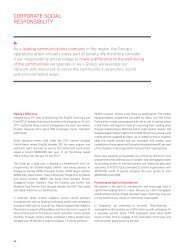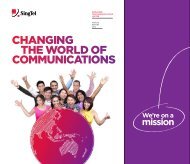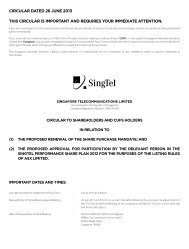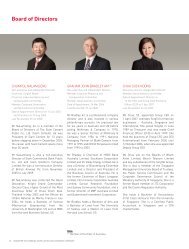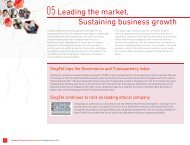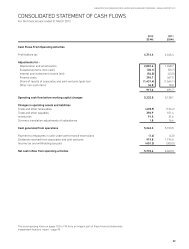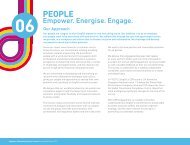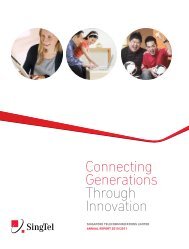Notes to the Financial Statements - SingTel
Notes to the Financial Statements - SingTel
Notes to the Financial Statements - SingTel
Create successful ePaper yourself
Turn your PDF publications into a flip-book with our unique Google optimized e-Paper software.
<strong>Notes</strong> <strong>to</strong> <strong>the</strong> <strong>Financial</strong> <strong>Statements</strong>For <strong>the</strong> financial year ended 31 March 20112.15 Intangible Assets (Cont’d)2.15.2 O<strong>the</strong>r intangible assetsExpenditure on telecommunication and spectrum licences is capitalised and amortised using <strong>the</strong> straight-line method over <strong>the</strong>irestimated useful lives of 12 <strong>to</strong> 25 years. Cus<strong>to</strong>mer relationships or cus<strong>to</strong>mer contracts acquired in business combinations arecarried at fair values at date of acquisition, and amortised on a straight-line basis over <strong>the</strong> period of <strong>the</strong> expected benefits, whichis estimated at 5 <strong>to</strong> 10 years.O<strong>the</strong>r intangible assets are stated at cost less accumulated amortisation and accumulated impairment losses.2.16 Impairment of Non-financial AssetsGoodwill on acquisition of subsidiaries, which has an indefinite useful life, is subject <strong>to</strong> annual impairment tests or morefrequently tested for impairment if events or changes in circumstances indicate that it might be impaired. Goodwill is notamortised (see Note 2.15.1).O<strong>the</strong>r intangible assets of <strong>the</strong> Group, which have definite useful lives and are subject <strong>to</strong> amortisation, as well as property,plant and equipment and investments in subsidiaries, associated and joint venture companies, are reviewed at <strong>the</strong> end of eachreporting period <strong>to</strong> determine whe<strong>the</strong>r <strong>the</strong>re is any indica<strong>to</strong>r for impairment, or whenever events or changes in circumstancesindicate that <strong>the</strong> carrying amount may not be recoverable. If any such indication exists, <strong>the</strong> assets’ recoverable amounts areestimated.For <strong>the</strong> purposes of assessing impairment, assets are grouped at <strong>the</strong> lowest levels for which <strong>the</strong>re are separately identifiablecash flows (cash-generating units).An impairment loss is recognised for <strong>the</strong> amount by which <strong>the</strong> asset’s carrying amount exceeds its recoverable amount. Therecoverable amount is <strong>the</strong> higher of <strong>the</strong> asset’s fair value less costs <strong>to</strong> sell and value-in-use.An impairment loss for an asset, o<strong>the</strong>r than goodwill on acquisition of subsidiaries, is reversed if, and only if, <strong>the</strong>re has beena change in <strong>the</strong> estimates used <strong>to</strong> determine <strong>the</strong> asset’s recoverable amount since <strong>the</strong> last impairment loss was recognised.Impairment loss on goodwill on acquisition of subsidiaries is not reversed in <strong>the</strong> subsequent period.2.17 Inven<strong>to</strong>riesInven<strong>to</strong>ries are stated at <strong>the</strong> lower of cost and net realisable value. Cost is determined on <strong>the</strong> weighted average basis. Netrealisable value is <strong>the</strong> estimated selling price in <strong>the</strong> ordinary course of business, less <strong>the</strong> estimated cost of completion andselling expenses.Work-in-progress is stated at costs less progress payments received and receivable on uncompleted information technologyand engineering services, and fibre rollout. Costs include third party hardware and software costs, direct labour and o<strong>the</strong>r directexpenses attributable <strong>to</strong> <strong>the</strong> project activity and associated profits recognised on projects-in-progress. When it is probable that<strong>to</strong>tal contract costs will exceed <strong>to</strong>tal contract revenue, <strong>the</strong> expected loss is recognised as an expense immediately.Work-in-progress is presented in <strong>the</strong> consolidated statement of financial position as “Work-in-progress” (as a current asset) or“Excess of progress billings over work-in-progress” (as a current liability) as applicable.Inven<strong>to</strong>ries include maintenance spares acquired for <strong>the</strong> purpose of replacing damaged or faulty plant or equipment. Until <strong>the</strong>yare used, <strong>the</strong>y are amortised over <strong>the</strong> useful life of <strong>the</strong> plant and equipment <strong>the</strong>y support. When used, <strong>the</strong> unamortised balanceis expensed.ANNUAL REPORT 2010/2011 111



